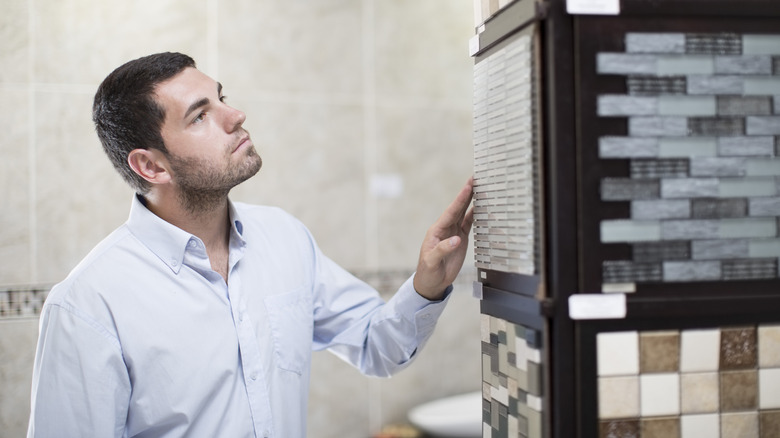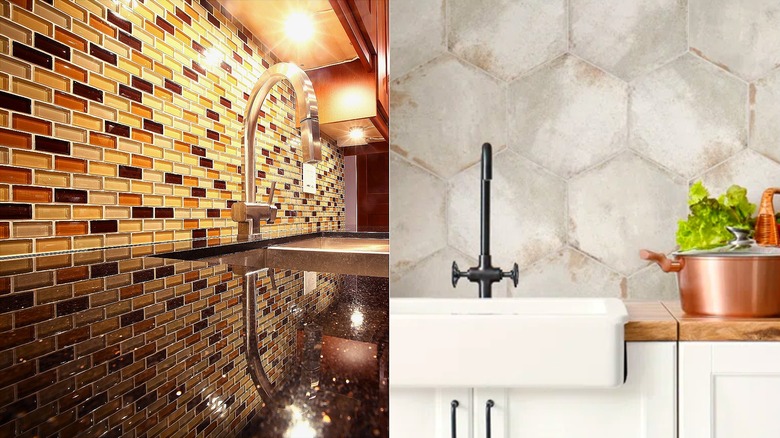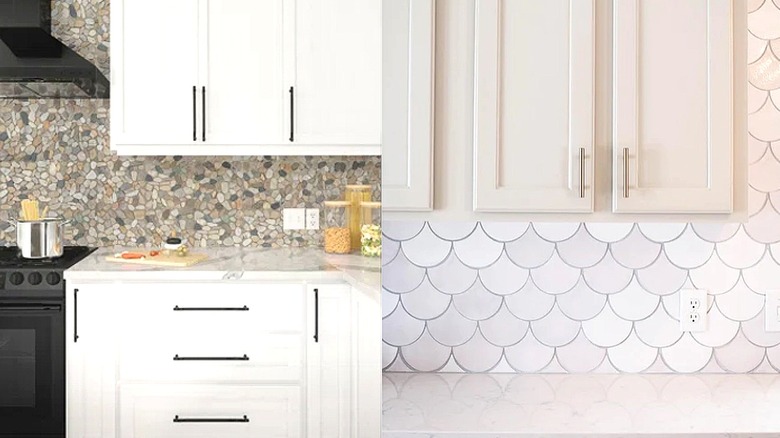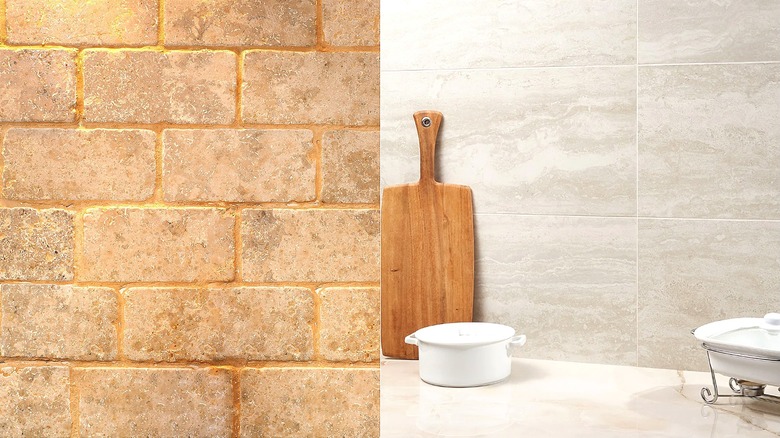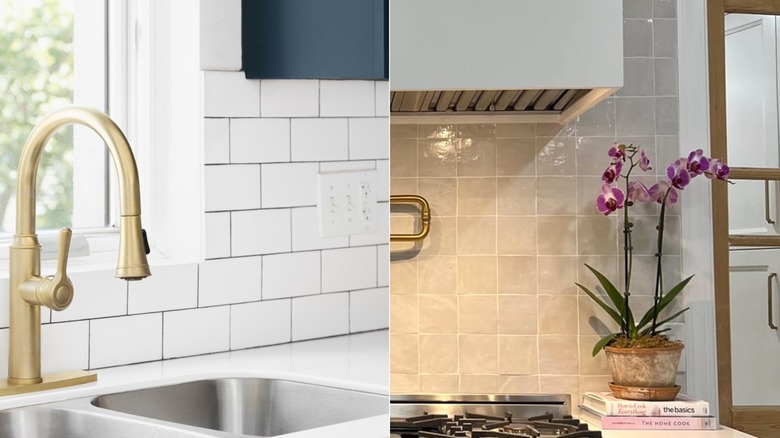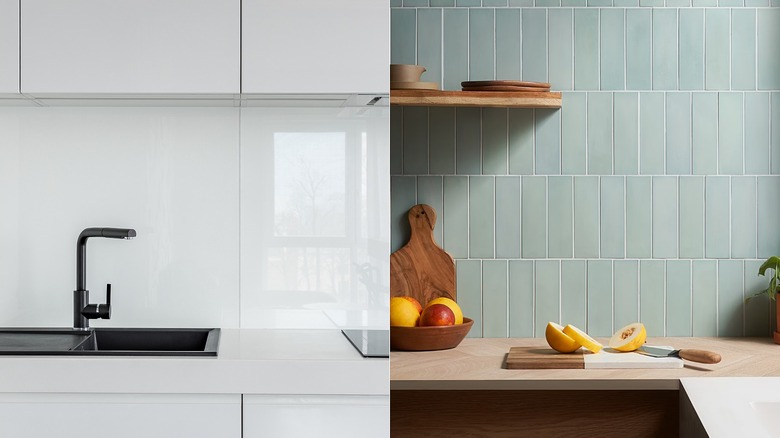The Worst Tile Backsplash Choices For Your Kitchen (& Better Alternatives)
The backsplash is one of the most crucial design elements of a kitchen. While the floor, cabinets, and countertops are also certainly important stylistically, the backsplash has the potential to become the focal design point of the space. Not to mention, it's also important functionally. A kitchen backsplash, especially one made from tile, can protect your walls from water damage and food and grease splatters. It's also going to be easier to clean than a standard painted wall, which is important for high traffic cooking areas. For such a central part of the kitchen it's important to select not just the right design, but also the right material. While some kitchen backsplashes may be made of brick veneer, wood, or laminate, the most popular option by far is tile. With that said, not all kitchen tile backsplashes are created equal, and some choices are far better than others.
Some things to consider when selecting tile material for your kitchen backsplash include how well the tile can hold up against moisture and food debris, how easy it is to clean, and also how well it matches the aesthetic of your kitchen. While certain tile materials are beautiful when applied in other parts of the home, they may become damaged over time when exposed to constant water and food splatters, which is the last thing you want to deal with when it comes to your beautiful, carefully selected tile backsplash choice. Here are some tiles you may want to avoid and potential alternatives you can use instead to create a beautiful and functional kitchen backsplash.
Pass on a colorful backsplash with tiny mosaic tiles
While tiny, colorful mosaic tiles can make an excellent accent wall in other parts of the home, like a recessed wall in the shower, they may not be the best option for your kitchen backsplash. A popular feature of mosaic tiles is that they draw your eyes to them, which can make a room seem more interesting. However, if your kitchen already has some bold design features or is overflowing with appliances and exposed shelves or flatware, mosaic tiles can make the space feel overly crowded.
Another reason to pass on a mosaic quirky kitchen backsplash design is because the tiles may be more difficult to clean than other options. Anyone who's ever had to clean tile knows that cleaning the grout can be difficult. It's important to consider that mosaic tiles have far more grout lines than larger tiles. In a potentially heavy mess area like a kitchen, it's likely that they're going to be subjected to all sorts of splatters, which could create an unnecessarily difficult cleaning job for you.
The good news is, you can still achieve a similar look stylistically to mosaic tiles by installing a kitchen backsplash with larger ceramic or porcelain tiles in a hex shape. The geometric appearance and feel of hexagon shaped tiles can replicate the mosaic style, even if they're larger. Plus, you can still find them in fun, beautiful colors that will give your backsplash personality. Most importantly, the larger hex tiles will have fewer pesky grout lines, which means your cleaning job won't be nearly as difficult.
Leave the pebble tiles in the bathroom
The uneven, natural, and serene look of pebble tiles makes them a popular choice for accent walls. However, pebble tiles may be better left in your bathroom, rather used on your wall for your kitchen backsplash. For one, pebble tiles can evoke feelings of serenity and peace, like you're in a spa. While this is a great way to feel when stepping into your bathroom, it may not be the energy you want to feel from the kitchen. Additionally, pebble tiles can be very difficult to clean, thanks to their uneven nature. All of the little pits and divots between the natural stones are the perfect place for little bits of grime to hide, which can lead to mold and other issues that you definitely don't want to deal with in your kitchen.
A lovely alternative to a pebble tile kitchen backsplash is to use fish scale tiles. The fish scale pattern gives the same flowy, natural appearance of the pebbles, just without the potential cleaning nightmare that can ensue from using pebble tiles as a kitchen backsplash. One of the biggest draws of pebble tiles is their natural appearance that evokes rivers and other bodies of water, and a fish scale tile can provide a similar feeling — just a little more toned down and appropriate for the kitchen. Opt for a white, gray, or soft blue to really lean into the ocean or river aesthetic of this creative backsplash idea for your kitchen.
Natural stone is beautiful, but maybe not for your kitchen backsplash
When deciding what type of tile material to use as your kitchen backsplash, it's almost impossible for natural stone not to cross your mind. It's beautiful, timeless, and can give your home a very earthy and natural appearance. However, despite its beauty and popularity, that doesn't mean that natural stone is a stellar choice for your kitchen backsplash. A big issue with natural stone is that it's very porous. This means that, untreated, water and other liquids can easily seep into the stones themselves. Over time, this may cause the stone to break and can even lead to mold growing in your kitchen backsplash, which is one of the last things you want in your kitchen.
Although it is possible to treat natural stone to give it some water resistance, this process needs to be repeated over time to keep the seal. Additionally, the porous nature of natural stones make them more likely to stain than other types of tile, which can be an issue cooking things like spaghetti and other colorful foods that can splatter onto the surface.
Don't fret if you have your heart set on a natural looking kitchen backsplash — you can still achieve this look by instead using porcelain tile. There are several different colors and designs of porcelain tiles that imitate the earthy colors of natural stone, so your kitchen can still have a balanced and natural-looking design. However, porcelain is far less porous than natural stone, which means that you won't have the same issues with cleaning it.
Sub the subway tiles for this alternative
Even though criteria like porosity and how easy it is to clean may be at the forefront of our minds when selecting a tile for the kitchen backsplash, style is also important for many. While that doesn't mean you need to follow interior design trends to a tee, it may be something to consider when selecting tiles for your kitchen backsplash. If you want to have a modern home design, you should avoid installing one with white subway tiles, as this is a kitchen backsplash trend that is totally dating your home.
Although some designers may feel that traditional subway tile is out, that doesn't mean that you can't still make it your own. If you are dead set on subway tiles but don't want a dated design, you can stack the tiles vertically to make them more modern. Or, you can upgrade the subway tile look and instead install a Zellige or variegated tile backsplash in a similar shape to subways, but with a totally refreshed style. A variegated tile backsplash in a lighter color like white, light gray, or off white can even strike a balance between the comfort of the classic white subway tile feel and the more natural elegance of Zellige tile.
Ultra glossy tiles aren't the best for your kitchen backsplash
The reflective gleam of glossy tiles is attractive in many parts of the home, especially in small rooms, as their reflectiveness can make the space seem bigger. However, glossy tiles may not be the best choice of tile material for the backsplash in your kitchen. The main reason why glossy tiles are a poor choice for your kitchen backsplash is that their reflectiveness also tends to show off fingerprints, smudges, dirt, food splatters, and any of their other imperfections on full display. In turn, this can make an otherwise tidy kitchen look dirty, unless you're incredibly meticulous with your cleaning.
A better alternative to glossy tiles in your kitchen if you're looking for a neater look is to install a matte tile backsplash. Matte tiles conceal marks and imperfections much better than tiles with a glossy finish. And, even though glossy tiles may be easier to clean, you likely won't have to clean a matte tile backsplash quite as often to keep it looking nice.
